Analysis of Patient Safety Issues in Medical Surgical Nursing
VerifiedAdded on 2022/12/19
|7
|1417
|1
Report
AI Summary
This report analyzes a patient safety incident involving a medication error in a medical surgical nursing setting. The incident involved a nurse administering an incorrect dose of morphine to a patient post-hip replacement surgery. The report details the event, highlighting the nurse's failure to adhere to the six rights of medication administration and the subsequent intervention to prevent adverse effects. It explores factors contributing to the error, including negligence, lack of knowledge in dosage calculation, and the importance of continuing professional development. The report emphasizes the significance of following established protocols and the nurse's positive action in reporting the error promptly. The conclusion underscores the need for specialty nurses to prioritize patient safety, maintain accountability, and engage in ongoing education to prevent future medication errors. References to relevant literature and standards are included, supporting the analysis and recommendations.

Running head: HEALTH CARE
Health care
Name of the student:
Name of the University:
Author’s note
Health care
Name of the student:
Name of the University:
Author’s note
Paraphrase This Document
Need a fresh take? Get an instant paraphrase of this document with our AI Paraphraser
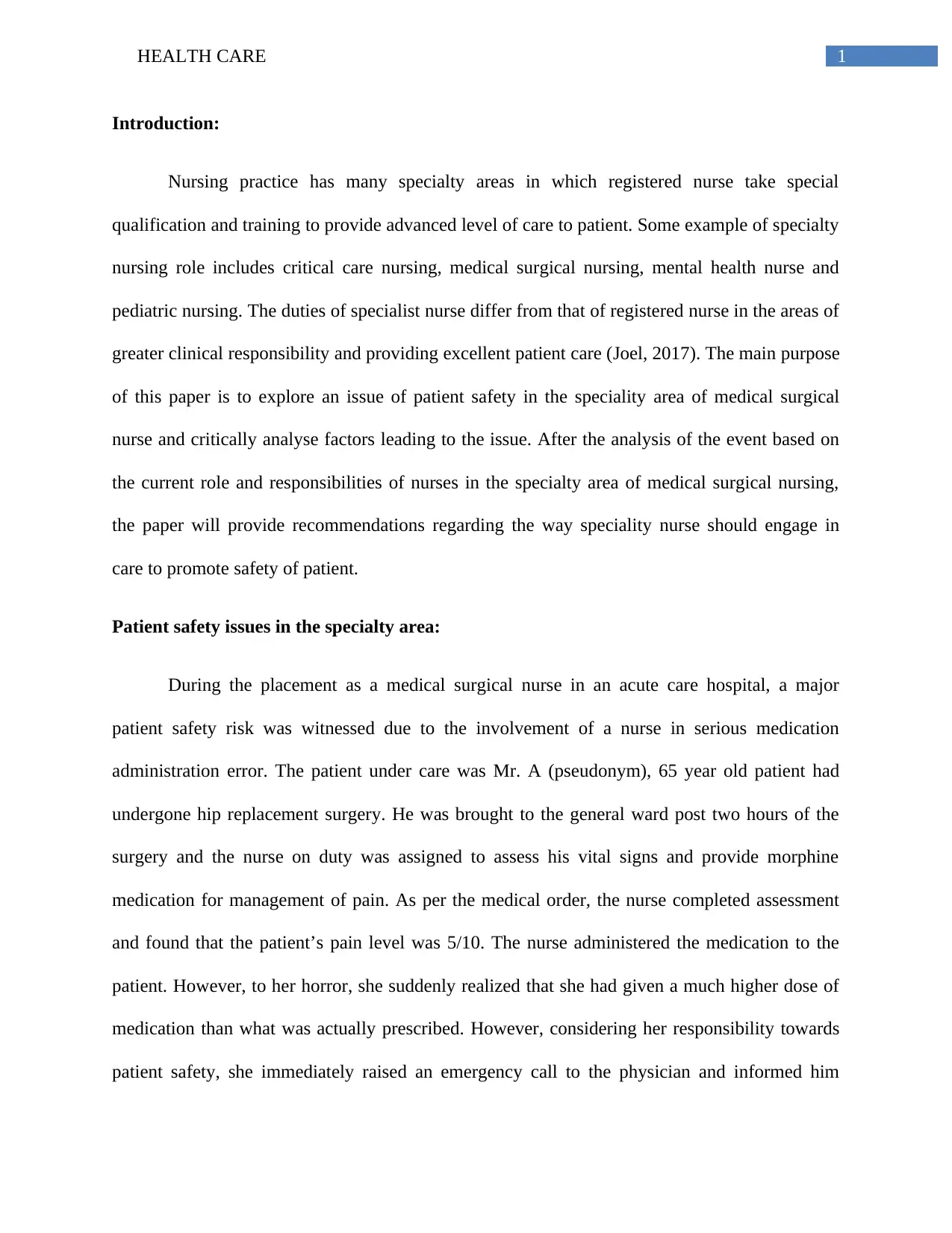
1HEALTH CARE
Introduction:
Nursing practice has many specialty areas in which registered nurse take special
qualification and training to provide advanced level of care to patient. Some example of specialty
nursing role includes critical care nursing, medical surgical nursing, mental health nurse and
pediatric nursing. The duties of specialist nurse differ from that of registered nurse in the areas of
greater clinical responsibility and providing excellent patient care (Joel, 2017). The main purpose
of this paper is to explore an issue of patient safety in the speciality area of medical surgical
nurse and critically analyse factors leading to the issue. After the analysis of the event based on
the current role and responsibilities of nurses in the specialty area of medical surgical nursing,
the paper will provide recommendations regarding the way speciality nurse should engage in
care to promote safety of patient.
Patient safety issues in the specialty area:
During the placement as a medical surgical nurse in an acute care hospital, a major
patient safety risk was witnessed due to the involvement of a nurse in serious medication
administration error. The patient under care was Mr. A (pseudonym), 65 year old patient had
undergone hip replacement surgery. He was brought to the general ward post two hours of the
surgery and the nurse on duty was assigned to assess his vital signs and provide morphine
medication for management of pain. As per the medical order, the nurse completed assessment
and found that the patient’s pain level was 5/10. The nurse administered the medication to the
patient. However, to her horror, she suddenly realized that she had given a much higher dose of
medication than what was actually prescribed. However, considering her responsibility towards
patient safety, she immediately raised an emergency call to the physician and informed him
Introduction:
Nursing practice has many specialty areas in which registered nurse take special
qualification and training to provide advanced level of care to patient. Some example of specialty
nursing role includes critical care nursing, medical surgical nursing, mental health nurse and
pediatric nursing. The duties of specialist nurse differ from that of registered nurse in the areas of
greater clinical responsibility and providing excellent patient care (Joel, 2017). The main purpose
of this paper is to explore an issue of patient safety in the speciality area of medical surgical
nurse and critically analyse factors leading to the issue. After the analysis of the event based on
the current role and responsibilities of nurses in the specialty area of medical surgical nursing,
the paper will provide recommendations regarding the way speciality nurse should engage in
care to promote safety of patient.
Patient safety issues in the specialty area:
During the placement as a medical surgical nurse in an acute care hospital, a major
patient safety risk was witnessed due to the involvement of a nurse in serious medication
administration error. The patient under care was Mr. A (pseudonym), 65 year old patient had
undergone hip replacement surgery. He was brought to the general ward post two hours of the
surgery and the nurse on duty was assigned to assess his vital signs and provide morphine
medication for management of pain. As per the medical order, the nurse completed assessment
and found that the patient’s pain level was 5/10. The nurse administered the medication to the
patient. However, to her horror, she suddenly realized that she had given a much higher dose of
medication than what was actually prescribed. However, considering her responsibility towards
patient safety, she immediately raised an emergency call to the physician and informed him
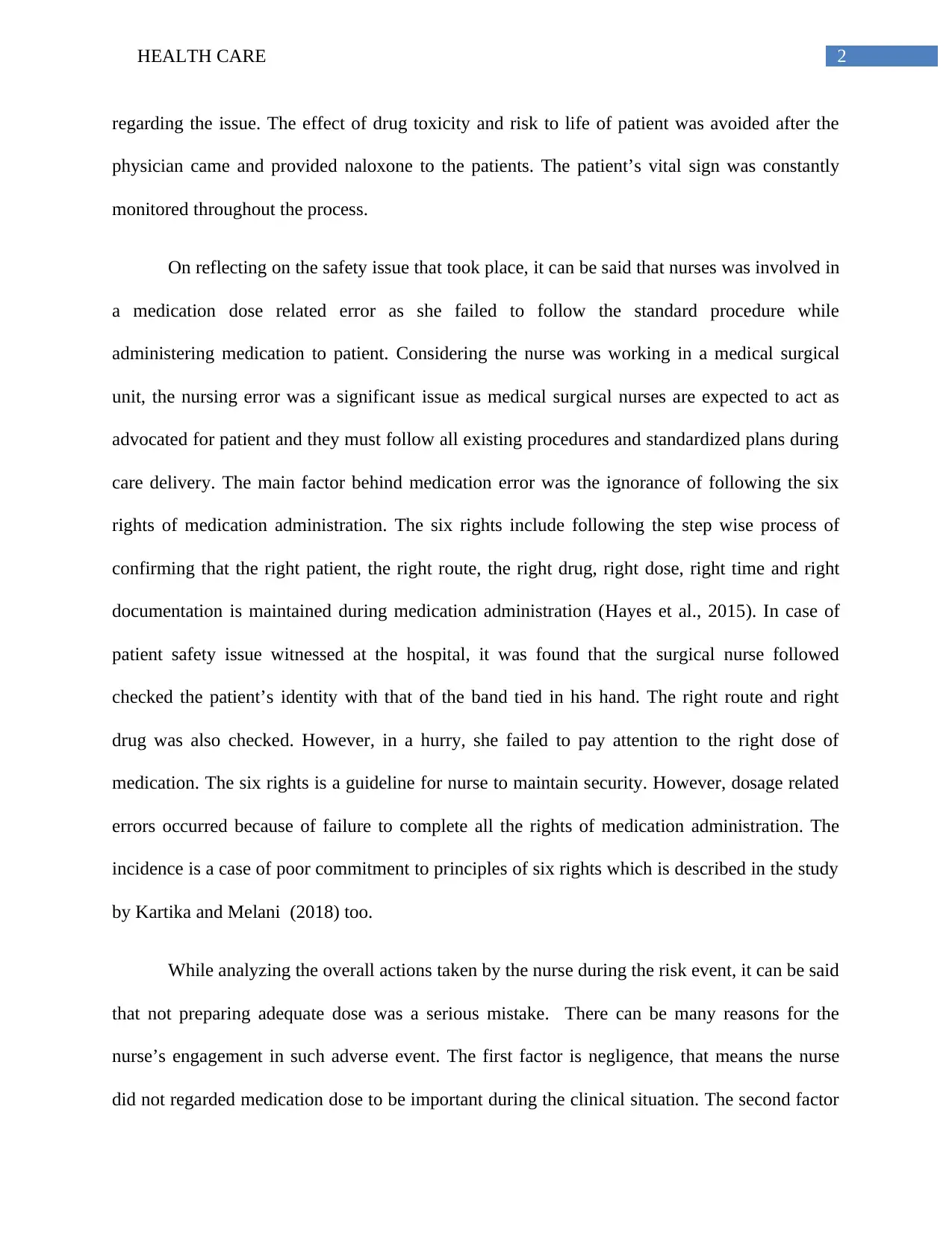
2HEALTH CARE
regarding the issue. The effect of drug toxicity and risk to life of patient was avoided after the
physician came and provided naloxone to the patients. The patient’s vital sign was constantly
monitored throughout the process.
On reflecting on the safety issue that took place, it can be said that nurses was involved in
a medication dose related error as she failed to follow the standard procedure while
administering medication to patient. Considering the nurse was working in a medical surgical
unit, the nursing error was a significant issue as medical surgical nurses are expected to act as
advocated for patient and they must follow all existing procedures and standardized plans during
care delivery. The main factor behind medication error was the ignorance of following the six
rights of medication administration. The six rights include following the step wise process of
confirming that the right patient, the right route, the right drug, right dose, right time and right
documentation is maintained during medication administration (Hayes et al., 2015). In case of
patient safety issue witnessed at the hospital, it was found that the surgical nurse followed
checked the patient’s identity with that of the band tied in his hand. The right route and right
drug was also checked. However, in a hurry, she failed to pay attention to the right dose of
medication. The six rights is a guideline for nurse to maintain security. However, dosage related
errors occurred because of failure to complete all the rights of medication administration. The
incidence is a case of poor commitment to principles of six rights which is described in the study
by Kartika and Melani (2018) too.
While analyzing the overall actions taken by the nurse during the risk event, it can be said
that not preparing adequate dose was a serious mistake. There can be many reasons for the
nurse’s engagement in such adverse event. The first factor is negligence, that means the nurse
did not regarded medication dose to be important during the clinical situation. The second factor
regarding the issue. The effect of drug toxicity and risk to life of patient was avoided after the
physician came and provided naloxone to the patients. The patient’s vital sign was constantly
monitored throughout the process.
On reflecting on the safety issue that took place, it can be said that nurses was involved in
a medication dose related error as she failed to follow the standard procedure while
administering medication to patient. Considering the nurse was working in a medical surgical
unit, the nursing error was a significant issue as medical surgical nurses are expected to act as
advocated for patient and they must follow all existing procedures and standardized plans during
care delivery. The main factor behind medication error was the ignorance of following the six
rights of medication administration. The six rights include following the step wise process of
confirming that the right patient, the right route, the right drug, right dose, right time and right
documentation is maintained during medication administration (Hayes et al., 2015). In case of
patient safety issue witnessed at the hospital, it was found that the surgical nurse followed
checked the patient’s identity with that of the band tied in his hand. The right route and right
drug was also checked. However, in a hurry, she failed to pay attention to the right dose of
medication. The six rights is a guideline for nurse to maintain security. However, dosage related
errors occurred because of failure to complete all the rights of medication administration. The
incidence is a case of poor commitment to principles of six rights which is described in the study
by Kartika and Melani (2018) too.
While analyzing the overall actions taken by the nurse during the risk event, it can be said
that not preparing adequate dose was a serious mistake. There can be many reasons for the
nurse’s engagement in such adverse event. The first factor is negligence, that means the nurse
did not regarded medication dose to be important during the clinical situation. The second factor
⊘ This is a preview!⊘
Do you want full access?
Subscribe today to unlock all pages.

Trusted by 1+ million students worldwide
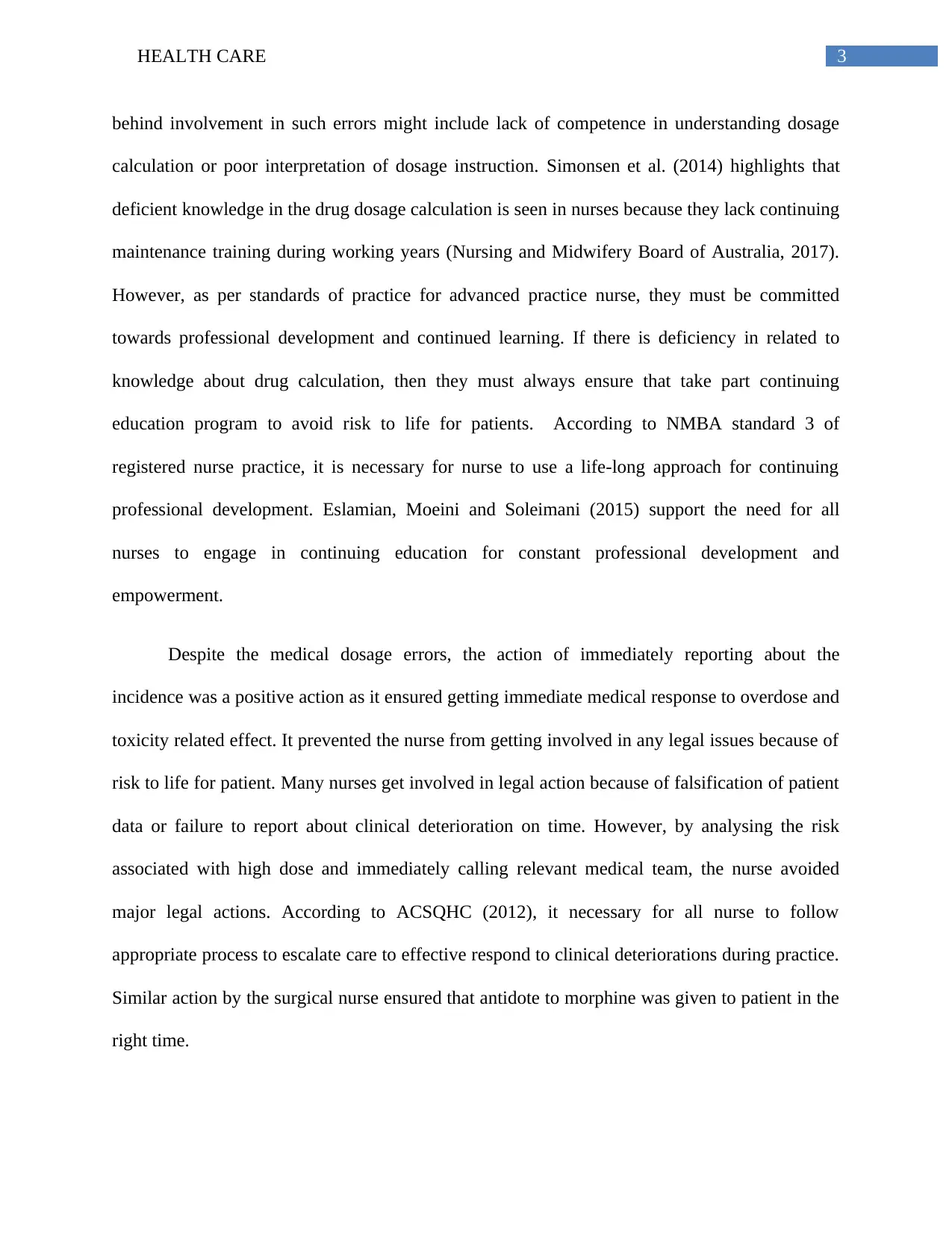
3HEALTH CARE
behind involvement in such errors might include lack of competence in understanding dosage
calculation or poor interpretation of dosage instruction. Simonsen et al. (2014) highlights that
deficient knowledge in the drug dosage calculation is seen in nurses because they lack continuing
maintenance training during working years (Nursing and Midwifery Board of Australia, 2017).
However, as per standards of practice for advanced practice nurse, they must be committed
towards professional development and continued learning. If there is deficiency in related to
knowledge about drug calculation, then they must always ensure that take part continuing
education program to avoid risk to life for patients. According to NMBA standard 3 of
registered nurse practice, it is necessary for nurse to use a life-long approach for continuing
professional development. Eslamian, Moeini and Soleimani (2015) support the need for all
nurses to engage in continuing education for constant professional development and
empowerment.
Despite the medical dosage errors, the action of immediately reporting about the
incidence was a positive action as it ensured getting immediate medical response to overdose and
toxicity related effect. It prevented the nurse from getting involved in any legal issues because of
risk to life for patient. Many nurses get involved in legal action because of falsification of patient
data or failure to report about clinical deterioration on time. However, by analysing the risk
associated with high dose and immediately calling relevant medical team, the nurse avoided
major legal actions. According to ACSQHC (2012), it necessary for all nurse to follow
appropriate process to escalate care to effective respond to clinical deteriorations during practice.
Similar action by the surgical nurse ensured that antidote to morphine was given to patient in the
right time.
behind involvement in such errors might include lack of competence in understanding dosage
calculation or poor interpretation of dosage instruction. Simonsen et al. (2014) highlights that
deficient knowledge in the drug dosage calculation is seen in nurses because they lack continuing
maintenance training during working years (Nursing and Midwifery Board of Australia, 2017).
However, as per standards of practice for advanced practice nurse, they must be committed
towards professional development and continued learning. If there is deficiency in related to
knowledge about drug calculation, then they must always ensure that take part continuing
education program to avoid risk to life for patients. According to NMBA standard 3 of
registered nurse practice, it is necessary for nurse to use a life-long approach for continuing
professional development. Eslamian, Moeini and Soleimani (2015) support the need for all
nurses to engage in continuing education for constant professional development and
empowerment.
Despite the medical dosage errors, the action of immediately reporting about the
incidence was a positive action as it ensured getting immediate medical response to overdose and
toxicity related effect. It prevented the nurse from getting involved in any legal issues because of
risk to life for patient. Many nurses get involved in legal action because of falsification of patient
data or failure to report about clinical deterioration on time. However, by analysing the risk
associated with high dose and immediately calling relevant medical team, the nurse avoided
major legal actions. According to ACSQHC (2012), it necessary for all nurse to follow
appropriate process to escalate care to effective respond to clinical deteriorations during practice.
Similar action by the surgical nurse ensured that antidote to morphine was given to patient in the
right time.
Paraphrase This Document
Need a fresh take? Get an instant paraphrase of this document with our AI Paraphraser
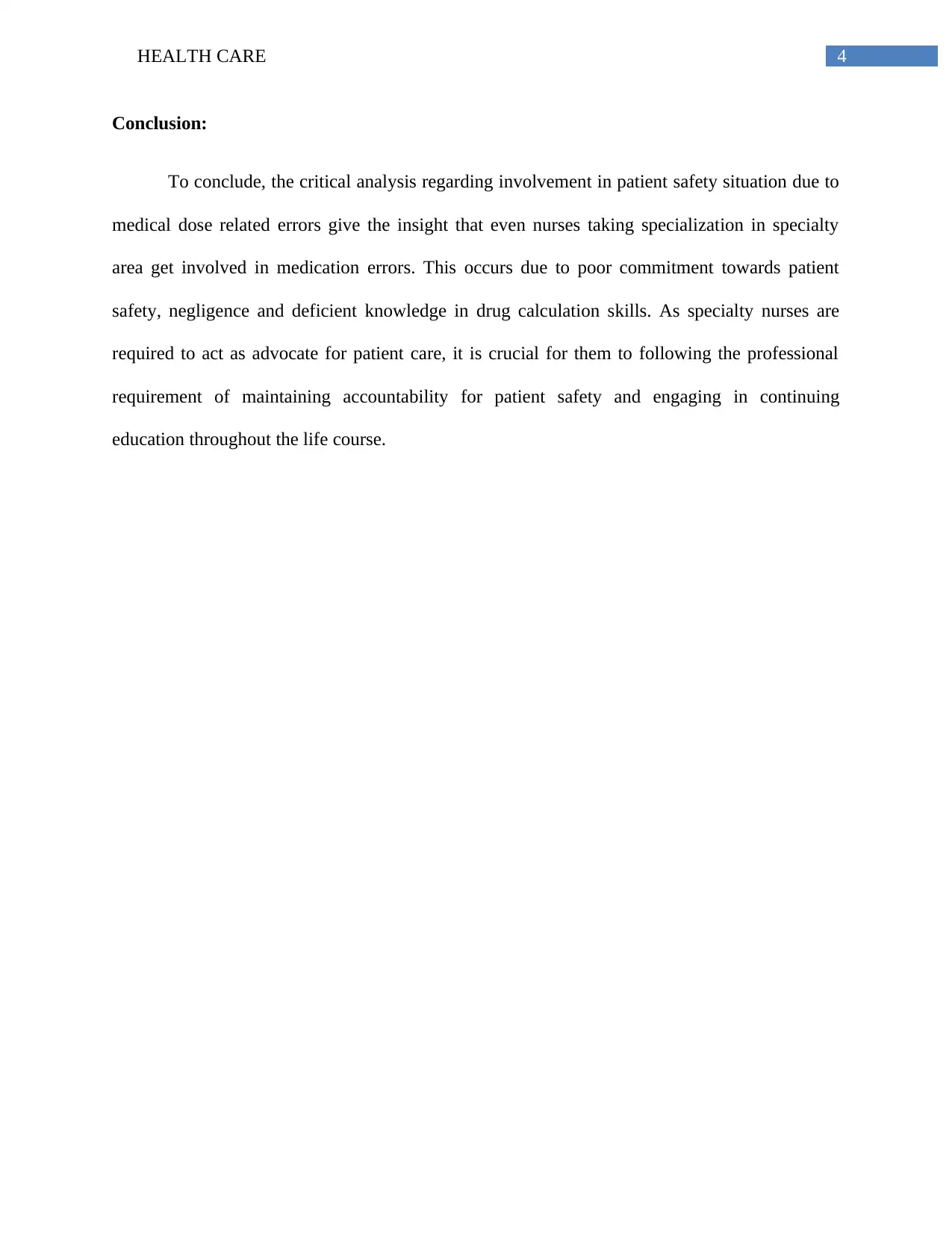
4HEALTH CARE
Conclusion:
To conclude, the critical analysis regarding involvement in patient safety situation due to
medical dose related errors give the insight that even nurses taking specialization in specialty
area get involved in medication errors. This occurs due to poor commitment towards patient
safety, negligence and deficient knowledge in drug calculation skills. As specialty nurses are
required to act as advocate for patient care, it is crucial for them to following the professional
requirement of maintaining accountability for patient safety and engaging in continuing
education throughout the life course.
Conclusion:
To conclude, the critical analysis regarding involvement in patient safety situation due to
medical dose related errors give the insight that even nurses taking specialization in specialty
area get involved in medication errors. This occurs due to poor commitment towards patient
safety, negligence and deficient knowledge in drug calculation skills. As specialty nurses are
required to act as advocate for patient care, it is crucial for them to following the professional
requirement of maintaining accountability for patient safety and engaging in continuing
education throughout the life course.
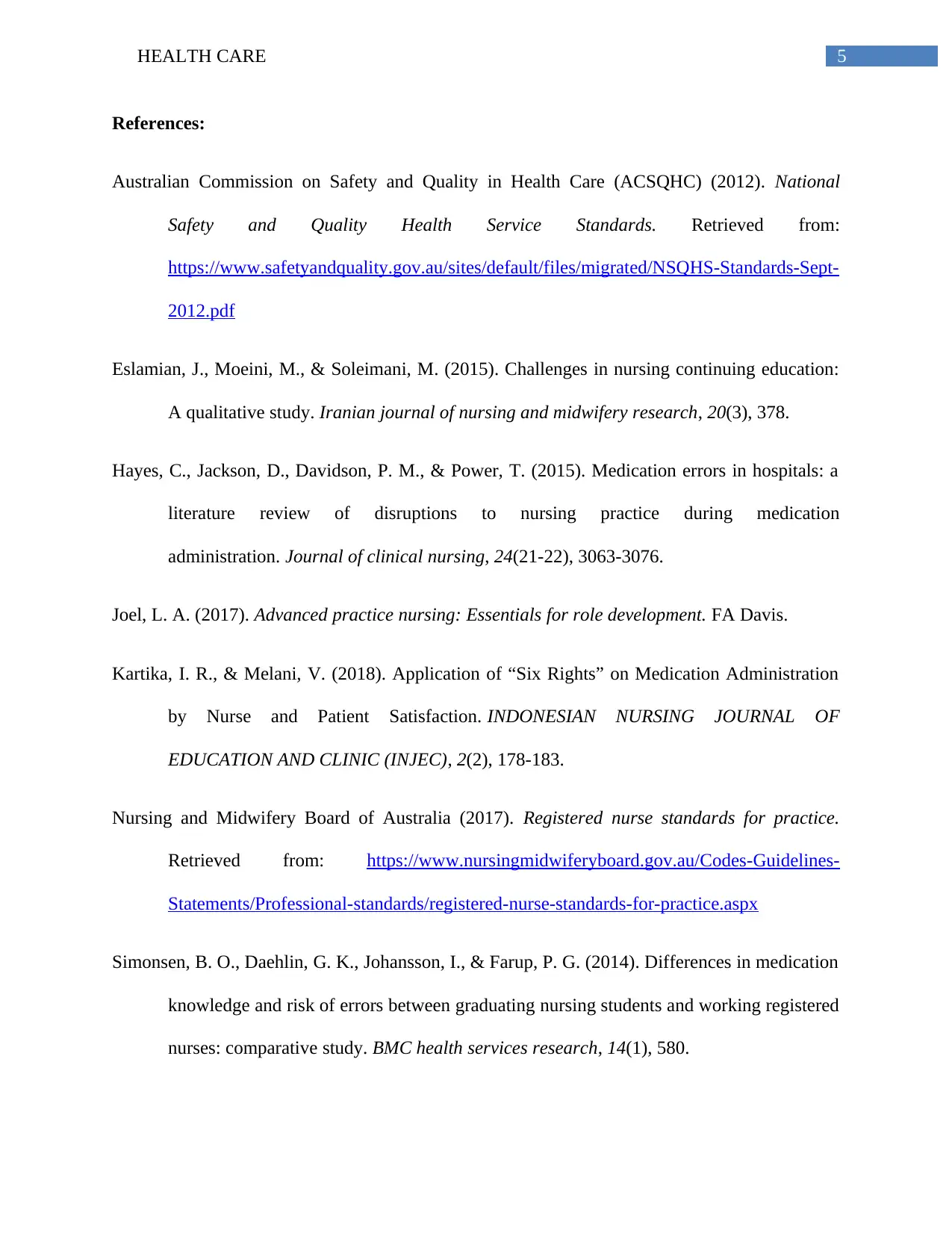
5HEALTH CARE
References:
Australian Commission on Safety and Quality in Health Care (ACSQHC) (2012). National
Safety and Quality Health Service Standards. Retrieved from:
https://www.safetyandquality.gov.au/sites/default/files/migrated/NSQHS-Standards-Sept-
2012.pdf
Eslamian, J., Moeini, M., & Soleimani, M. (2015). Challenges in nursing continuing education:
A qualitative study. Iranian journal of nursing and midwifery research, 20(3), 378.
Hayes, C., Jackson, D., Davidson, P. M., & Power, T. (2015). Medication errors in hospitals: a
literature review of disruptions to nursing practice during medication
administration. Journal of clinical nursing, 24(21-22), 3063-3076.
Joel, L. A. (2017). Advanced practice nursing: Essentials for role development. FA Davis.
Kartika, I. R., & Melani, V. (2018). Application of “Six Rights” on Medication Administration
by Nurse and Patient Satisfaction. INDONESIAN NURSING JOURNAL OF
EDUCATION AND CLINIC (INJEC), 2(2), 178-183.
Nursing and Midwifery Board of Australia (2017). Registered nurse standards for practice.
Retrieved from: https://www.nursingmidwiferyboard.gov.au/Codes-Guidelines-
Statements/Professional-standards/registered-nurse-standards-for-practice.aspx
Simonsen, B. O., Daehlin, G. K., Johansson, I., & Farup, P. G. (2014). Differences in medication
knowledge and risk of errors between graduating nursing students and working registered
nurses: comparative study. BMC health services research, 14(1), 580.
References:
Australian Commission on Safety and Quality in Health Care (ACSQHC) (2012). National
Safety and Quality Health Service Standards. Retrieved from:
https://www.safetyandquality.gov.au/sites/default/files/migrated/NSQHS-Standards-Sept-
2012.pdf
Eslamian, J., Moeini, M., & Soleimani, M. (2015). Challenges in nursing continuing education:
A qualitative study. Iranian journal of nursing and midwifery research, 20(3), 378.
Hayes, C., Jackson, D., Davidson, P. M., & Power, T. (2015). Medication errors in hospitals: a
literature review of disruptions to nursing practice during medication
administration. Journal of clinical nursing, 24(21-22), 3063-3076.
Joel, L. A. (2017). Advanced practice nursing: Essentials for role development. FA Davis.
Kartika, I. R., & Melani, V. (2018). Application of “Six Rights” on Medication Administration
by Nurse and Patient Satisfaction. INDONESIAN NURSING JOURNAL OF
EDUCATION AND CLINIC (INJEC), 2(2), 178-183.
Nursing and Midwifery Board of Australia (2017). Registered nurse standards for practice.
Retrieved from: https://www.nursingmidwiferyboard.gov.au/Codes-Guidelines-
Statements/Professional-standards/registered-nurse-standards-for-practice.aspx
Simonsen, B. O., Daehlin, G. K., Johansson, I., & Farup, P. G. (2014). Differences in medication
knowledge and risk of errors between graduating nursing students and working registered
nurses: comparative study. BMC health services research, 14(1), 580.
⊘ This is a preview!⊘
Do you want full access?
Subscribe today to unlock all pages.

Trusted by 1+ million students worldwide
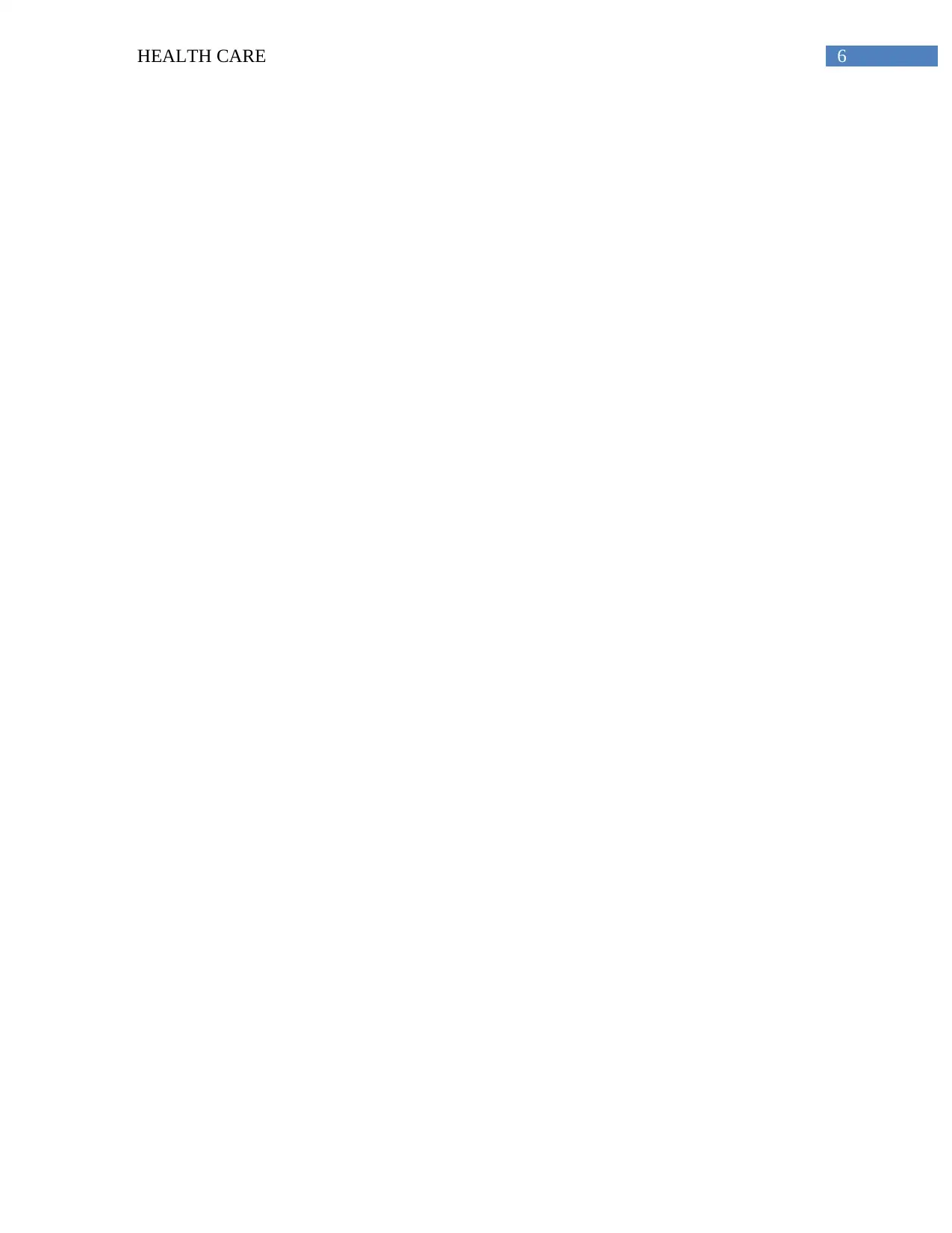
6HEALTH CARE
1 out of 7
Related Documents
Your All-in-One AI-Powered Toolkit for Academic Success.
+13062052269
info@desklib.com
Available 24*7 on WhatsApp / Email
![[object Object]](/_next/static/media/star-bottom.7253800d.svg)
Unlock your academic potential
Copyright © 2020–2025 A2Z Services. All Rights Reserved. Developed and managed by ZUCOL.





